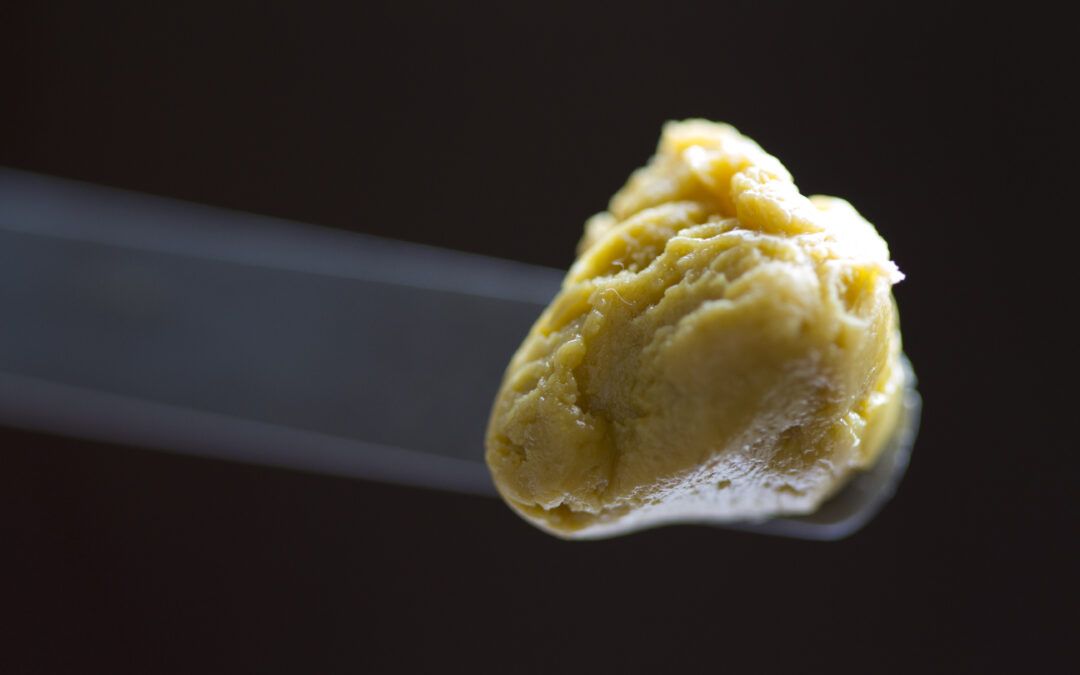Cannabis wax is known for being a highly potent concentrate, containing around three times as much THC compared to regular marijuana. For this reason, it’s a popular choice for lots of people; whether you’re looking for a high THC option for pain relief, relaxation, anxiety, insomnia, or other reasons. Cannabis wax also concentrates the scents and tastes of different weed strains, so there are plenty of options to explore and to find your favorite blend.
What is weed wax?
Weed wax, also known as dabs or butane hash oil (BHO), is a type of marijuana concentrate. This category also includes rosin, shatter, hash, oil, resin, and sugar. While it’s known primarily as cannabis ‘wax’, this particular type of concentrate can actually come in a wide variety of forms.
The wax can range from a sticky, opaque amber substance that resembles butter (and may be labeled as ‘butter’) to a honeycomb-like structure that is brittle and crumbly, also known as cake icing or crumbling. Whether you prefer a more waxy concentrate or a sticky consistency will depend on your preference and the way you want to consume it.
First, let’s go into a little more detail about how cannabis wax is produced, and what makes it different from other concentrates.
How is weed wax made?
In order to get such a concentrated THC level (around 90% compared to a marijuana flower’s 30%), plant material from marijuana buds and trimmings are super heated using butane as a solvent, in order to extract the highly prized resin from the plant material, producing a potent concentrate which can be heated, refined and cool to form the sticky wax we’re all after.
Butane is a flammable and unstable material, which is why it’s not a good idea to try creating your own marijuana wax at home. In professional operations, a closed loop system is used which completely removes the butane and other solvent materials in order to produce a pure product for sale.
How do you use cannabis wax?
So, you know what weed wax is and how it’s made, but what is the best method for using it? Well, that depends on your level of experience, what you want to get out of marijuana wax, and your tolerance to THC. In general, there are three approaches you can take: dabbing, vape pens and traditional smoking methods.
Dabbing and oil rigs
One of the popular ways to use weed wax is dabbing. Dab rigs are relatively easy to use and properly heat up the cannabinoids and terpenes to give you an immediate effect. A dab or oil rig is essentially a bong with a ‘nail’ – an attachment made of ceramic or titanium that allows you to ingest concentrates specifically. A small blowtorch is used to heat up the nail, and then a dab of cannabis wax can be added and the heated material inhaled.
It’s worth noting that the inclusion of an open flame and high heats with dab rigs may not be ideal for beginners, and it does require a practiced and steady hand to operate.
Vape pens
If you’re looking for a more efficient and mess-free way to enjoy your cannabis wax, vape pens could be the answer. Vapes can reach the high temperatures needed to get the full benefits from wax, but they are easier to use and feel similar to smoking regular weed.
With a vape pen that’s made for smoking wax, you just need to add a dab of wax to the heating chamber and then inhale the vapor that’s produced. Remember, cannabis wax is stronger than the regular flower — Go low and slow when using the vaping method, so you can get a feel for how quickly the wax’s effects can be felt and how much more potent it is compared to vaping plant material.
Weed wax joints and bowls
Adding a dab of weed wax to traditional smoking methods like joints and bowls can add a new level of intensity to your smoking experience. Simply add a dab of weed wax into the flower you’re planning to roll into a joint or blunt, and you’ll get a slower burning, more potent result.
This is a lower heat option than the other two methods, so if you splurged on a really premium weed wax, this might not be the best use to fully appreciate the product.
What are the benefits of using cannabis wax?
There are lots of reasons why you might choose to use cannabis wax over flower or other weed products.
- It’s more shelf stable — Unlike regular marijuana which needs to be kept in certain conditions, doesn’t have a super long shelf life, and can dry out, weed wax won’t lose its potency as easily. This can make it a good option for anyone who wants to buy in bulk, or tends to only use weed on rare occasions.
- It’s a good option for users with a higher tolerance — If you’ve been smoking weed for its calming or pain killing properties, you may find that over time your tolerance to THC has heightened, and you need to smoke more to achieve the desired results. In these cases, weed wax is an ideal alternative. You’ll only need a smaller amount to get the same therapeutic benefits from wax concentrate.
- There’s a better flavor — Cannabis wax can amplify the natural flavors and aromas, like terpenes and flavonoids, of different weed strains. If you’re a connoisseur and enjoy discovering different blends and strains, weed wax may be ideal, and you can explore a world of diverse flavors available on the market from different producers.
- You’ll feel the effects fast — Part of cannabis wax’s potency is that you’ll quickly feel the effects after dabbing or smoking it almost immediately. Especially if you’re using weed wax for pain relief, this faster onset can suit people better than smoking plant material, and it’s definitely better for feeling the immediate effects when compared to edibles.
Where can I buy cannabis wax?
Whether you’re already a huge fan of dabbing, looking for an instant release cannabis option for quick relief, or just experimenting with these potent and highly varied concentrates, Shango has a great range of cannabis wax extracts for you to discover. Check out our selection of strains and varieties and find your new favorite, or ask us for our latest recommendations and new releases.
Want to know more about the wonderful world of weed? Check out our ultimate marijuana guide to discover more about different strains of weed, how to identify them, and what they’re best suited for.


